Ysart Tradition and Scottish Glass 2005
GLASS CONFERENCE
Reported by Nigel Benson
Photographs by Denis Hebden
Perth Museum & Art Gallery - August 6th and 7th 2005
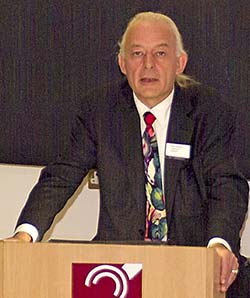 |
|
Conference organiser Frank Andrews |
The conference ran over two days, 6 & 7 August 2005, and was organised using the Internet, from inception through to registration. An idea by New Zealand glass collector, Bill Smith, using the pages of the Ysart Glass message board on, www.glass.co.nz to pressurise its moderator, Frank Andrews to plan a meeting, culminated in a highly successful weekend for both learning and socialising.
Speakers included two glass blowers, Dave Moir and Peter Holmes, who had trained and worked with members of the Ysart family – Vincent and Paul respectively; Catherine Rae, Vincent’s daughter; Ian Turner, historian and writer about Monart (and past President of the GA); Brian Blench, retired Keeper of Decorative Arts at Glasgow Museums and Art Galleries, Scotland, and founding chairman of the Scottish Glass Association; Kevin Holt a collector and researcher of paperweights; and Ray Metcalfe, dealer in paperweights.
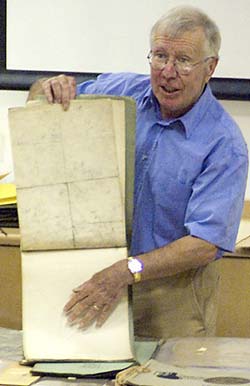 |
|
Conference speaker Ian Turner |
During his talk Ian discussed the use of coloured enamels and their source within the various firms that the Ysart family worked with. An important feature of, Monart, Vasart and Strathearn, as well as subsequently Ysart influenced glass is what was referred to as the ‘Ysart Swirl’. This is a swirl of colour produced within the glass by using a metal tool with a whirling action to produce the swirl whilst the metal is still on the blowing iron. This technique was imparted to some apprentices and glass blowers and can be traced from the original wares through Caithness Glass and is currently used by Peter Holmes in his art glass production, and in Franco Toffolo’s work. Dave Moir, who has only recently returned to glass making after being away since he left Strathearn Glass when they ceased production of coloured art glass is now making vessels using this same decorative technique. During the break immediately after the talk Ian Turner formally donated all his original documents to Perth Museum and Art Gallery. These consisted mainly of various Monart catalogues, including the lighting catalogue that was featured within Ian’s article on the subject in The Journal, Vol.7. His correspondence with Betty Reid also formed part of the donation. Councillor Elizabeth Grant of Perth and Kinross District Council accepted the donation on behalf of Perth Museum and Art Gallery in a ceremony that was separate from the conference.
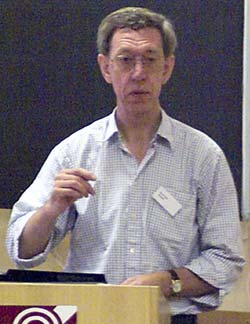 |
|
Kevin Holt |
Kevin Holt was introduced as a glass archaeologist, rather than historian. He discussed his observations and theories regarding the use of canes and their dating in Ysart paperweights and their successors made at Perthshire Paperweights, by Willy Manson, John Deacons and Peter Holmes.
Kevin talked about the use of an ‘S’ cane, the butterfly cane and their origins and importance. The use of canes in Monart glassware and their relationship to paperweight use and dating was of particular interest. Frank Eisner weights and their dating were also discussed. Much of what Kevin spoke about had not been resolved, but he took the opportunity to lay out his thoughts to an audience who might well give input to Kevin’s ‘archaeology’ of the subject.






PY & Vasart
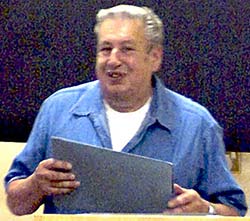 |
|
Dave Moir |
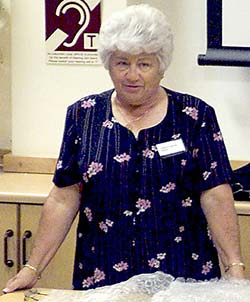 |
|
Catherine Rae (nee Ysart) |
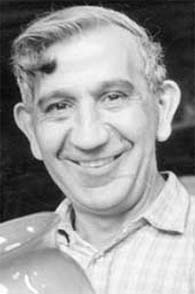 |
|
Vincent Ysart |
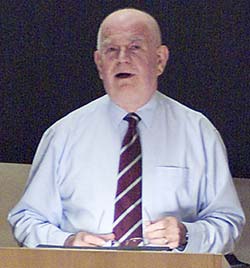 |
|
Brian Blench |
The First World War affected the Scottish glass industry badly, such that new workers were required. This is where the Ysarts history begins within Scottish glass. However, since the audience were aware of the Ysart history, Brian then discussed the hugely influential affect of Helen Monroe, her rise within the glass industry at Edinburgh & Leith and her work both as an engraver and as teacher within Edinburgh College of Art. Her strength of purpose and her ideas about design being linked to glass making were to be particularly significant to post-war glass making. It was she who re-introduced the art of engraving on glass in the UK, but she did not force it onto her pupils preferring to allow them to show their own interest within the canon of glass making and design. Her influence can still be felt today through the work of Alison Geissler and Alison Kinnaird.
Here Brian returned to the Ysarts talking about Isobel Moncrieff’s A Friendly Talk on Monart Ware of 1925 and its use as a marketing tool. Having spoken generally about adaptability of the Ysarts as glassblowers the talk moved onto Strathearn Glass and Perthshire Paperweights, their physical proximity in Crieff, and their rivalry. Then followed the rise of Caithness Glass, initially under the auspices of Domhnall OBroin as Managing Director and Chief Designer, then through Colin Terris, another of Helen Monroe’s graduates. Although Paul Ysart was taken on as Training Officer and Technical Advisor the paperweights produced by the company took a distinct turn toward the abstract style as opposed to the traditional milleflori. Mention was made of John Laurie, the stained glass designer, who took over at the College of Art and his successor Ray Flavell, bringing us through to production and influences nowadays.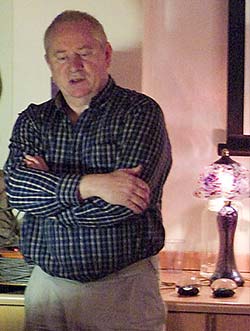 |
|
Peter Homes |
Peter Holmes talked of his time as an apprentice to Paul Ysart and what it was like to work with a man who had high demands. We were treated to a number of personal anecdotes about Paul, as well as being given an insight into the man himself. When Peter set up Selkirk Glass they were having trouble with the mix and Paul’s advice was sought on the ‘phone. The problems did not abate, so Paul travelled down and spent several days sorting out the problem. The first melt, although poor, was used up by making ‘Monart’. Peter continued by talking about Paul and his time at Caithness, followed by the period making paperweights at Harland and the closing of that period of Ysart history. Peter’s son, Andrew, is now his apprentice at Scottish Borders Art Glass, so continuing the history of Scottish glass and the Ysart influence.
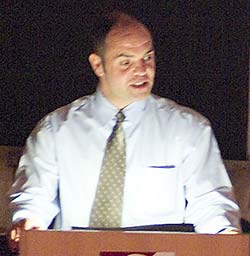 |
|
Ray Metcalfe |
© 2005 Nigel Benson – An article originally published in the GLASS CONE No. 71, Summer Issue, Oct 2005, the magazine of the Glass Association. (With different pictures).
All photographs on this page are © 2005 Denis Hebden.
Nigel Benson has a website at www.20thcentury-glass.com
Kevin Holt’s research is published online at www.kevh.glass.btinternet.co.uk
Peter Holmes studio has a website at www.scottishbordersartglass.com
Ray Metcalfe’s Sweetbriar Gallery is at www.sweetbriar.co.uk
The Scottish Glass Society is online at www.scottishglasssociety.com
The Glass Association can be found at www.glassassociation.org.uk